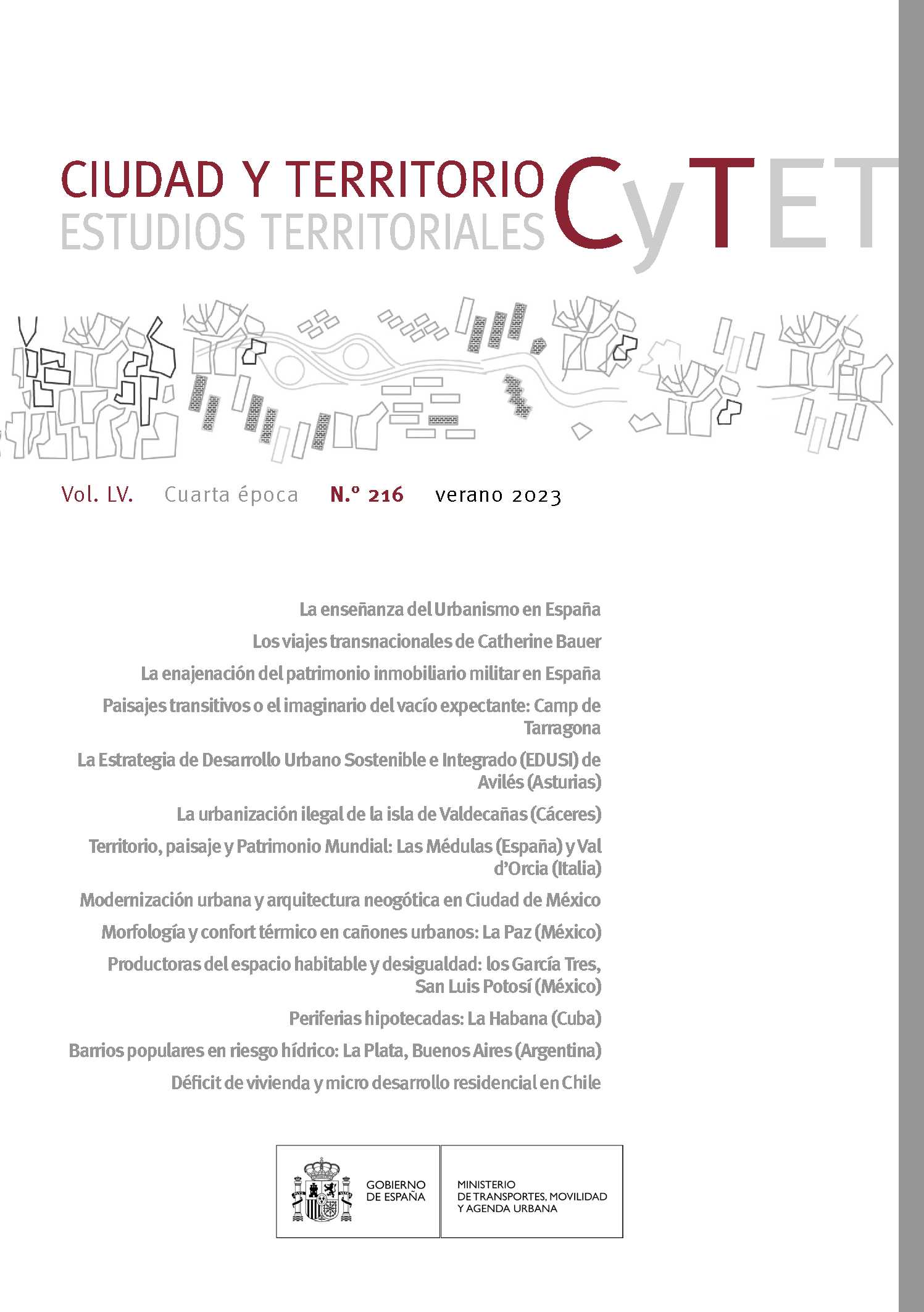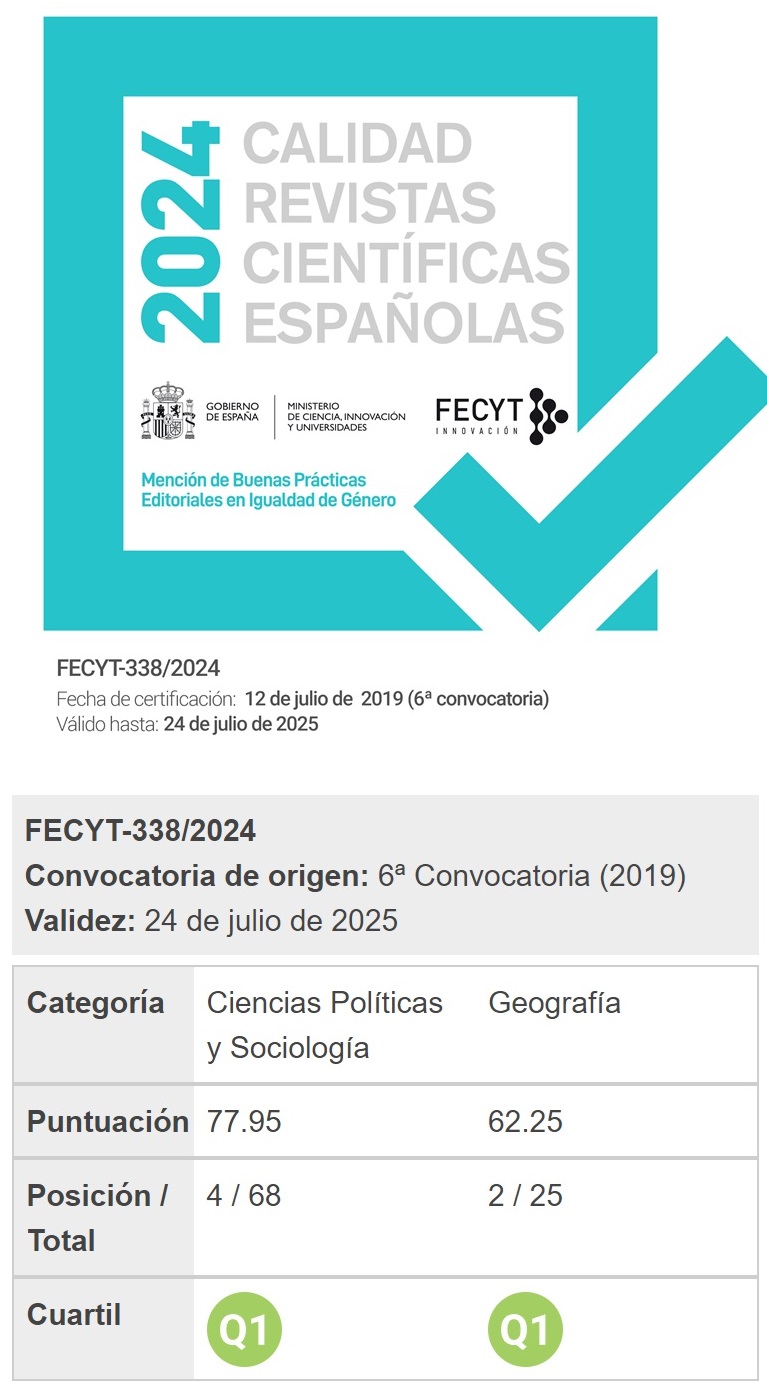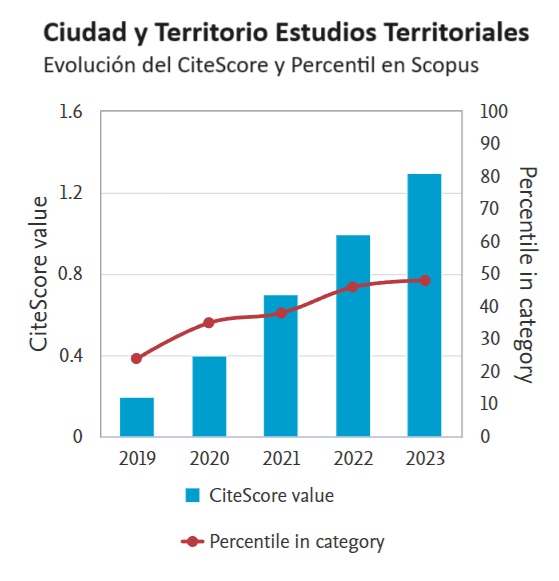De paisaje de transición a lugar transitivo: aproximación visual a la gramática territorial contemporánea a partir de sus vacíos expectantes en el Camp de Tarragona
DOI:
https://doi.org/10.37230/CyTET.2023.216.4Palabras clave:
Periferia urbana, Vacío expectante, Lugar transitivo, Terrain Vague, Camp de TarragonaResumen
Estimulada por la inquietante condición de incertidumbre y expectancia dominante, esta investigación sondea y cataloga los paisajes vacíos del periurbano de Tarragona. Para ello, parte de un marco teórico que da cuenta de la dispersión conceptual y epistemológica y revela el papel fundamental de la fotografía en el descubrimiento y tratamiento de la disciplina urbanística de estos fragmentos de terra ignota. Con la voluntad de caracterizar dichos espacios baldíos, el segundo bloque del artículo propone la (re)colección sistematizada de imágenes de terrain vagues y la construcción de un atlas del vacío a partir del método de análisis visual-relacional que aplicó el historiador del arte Aby Warburg. Por último, una serie de categorías específicas sugieren, a modo de resultados, nuevas vías de aproximación disciplinar al valor y potencial de estos paisajes transitivos.
Descargas
Citas
Ábalos, I., Herreros, J. (1997): Áreas de impunidad. Barcelona: Actar.
Acebillo, J. & Lévy, J. & Schmid, C. (2013): Globalization of Urbanity. Barcelona: Actar.
Agamben, G. (2007): Aby Warburg y la ciencia sin nombre, en La potencia del pensamiento. Buenos Aires: Adriana Hidalgo Ed.
Amidon, J. (2001): Radical Landscapes: Reinventing Outdoor Space. London: Thames & Hudson.
Arets, W. & al. (2001): Strange conditions. Catedra Mies Van der Rohe. Barcelona: ETSAB.
Armstrong, H. (2006): Time, Dereliction and Beauty: An Argument for Landscapes of Contempt, The Landscape Architect. Seoul: IFLA Eastern Region Conference Proceeding Book.
Augé, M. (1992): Non-Lieux. Introduction à une anthropologie de la surmodernité. Paris: Seuil.
Bachelard, G. & Jolas, M. (1994): The poetics of space. Boston: Beacon Press.
Barthes, R. (1972): Critical Essays. Evanston: Northwestern University Press.
Basilico, G. (2008): Entropía y espacio urbano. Madrid: La fábrica.
Basilico, G. & Bernadó, J. (1999): Interrupted City: Gabriele Basilico : La Ciudad Interrumpida. Barcelona: Actar.
Berger, A. (2006): Drosscape Wasting Land in Urban America. New York: Princeton Architectural Press.
Bernadó, J. (2000): On the Limits. Barcelona: Actar.
Bordieu, P. (1965): Un art moyen; essai sur les usages sociaux de la photographie. Paris: Minuit.
Bowman, A. & Pagano, O. (2004): Terra Incognita: Vacant Land and Urban Strategies. Washington, D.C.: Georgetown University Press.
Burdett, R. & Rode, P. (2018): Shaping Cities. London: London School of Economics/Phaidon Press Ltd.
Careri, F. (2002): Walkscapes: Walking as an Aesthetic Practice. Barcelona: Editorial Gustavo Gili.
Clément, G. (2004): Le Tiers Paysage. Paris : Editions Sujet/Objet.
Corboz, A. (1985): Il territorio come palimsesto. Milano: Casabella, 516.
Davidson, C. (1995): Anyplace. Cambridge: Anyone Corporation, MIT Press.
Debord, G. (1958): Théorie de la derive en Les lèvres nues. Paris : Internationale situationiste.
Dendrinos, D. (1992): The dynamics of Cities. Ecological determinism, dualism and chaos. Routledge, London.
De Soto, H. (2001): The Mystery of Capital. Why Capitalism Triumphs in the West and Fails Everywhere Else. London: Bantam Press.
Diller, E. & Scofidio, R. (2002): Blur: The Making of Nothing. Harry N. Abrams.
Eisenman, P. (2007): Written into the Void: Selected Writings, 1990-2004. New Haven: Yale University Press.
Font, A. (2006): La explosión de la ciudad: Transformaciones territoriales recientes en las regiones urbanas de Europa Meridional. Ministerio de la Vivienda. Madrid 2006
Foucault, M. (1994): Eterotopía, luoghi e non-luoghi metropolitani. Milano: Millepiani.
Giménez, A. (2021): La excepción: tres dimensiones de la discontinuidad en el paisaje de la Barcelona contemporánea. Tesis doctoral. Barcelona: DUOT-UPC.
Goula, M. (2006): Los otros paisajes. Lecturas de imagen variable. Tesis doctoral UPC. Barcelona: Departamento de Urbanismo y Ordenación del Territorio.
Grávalos-Lacambra, I. & Di-Monte, P. (2022): Nuevos paradigmas de la ciudad inacabada: la reactivación de espacios abandonados mediante usos temporales. Ciudad y Territorio Estudios Territoriales, 54(214), 799-812.
https://doi.org/10.37230/CyTET.2022.214.1
Harvey, D. (2000): Spaces of Hope. Berkeley: University of California Press.
Harvey, D. (2005): Spaces of Neoliberalization: Towards a Theory of Uneven Geographical Development. Franz Steiner Verlag.
Hayden, D. (1997): The power of place. Urban landscapes as public history. Cambridge: The MIT Press.
Heynen, H. (1992): The Peripherial Condition. Some thoughts about a problematic phenomenon, illustrated by case study in Winterslag. Barcelona: Revista UR 9-10: 57-59 en Proyectar la periferia, Laboratori d’Urbanisme ETSAB-UPC.
Koolhaas, R. (1998): SMLXL. New York: Monacelli Press.
Koolhaas, R. (2004): Acerca de la ciudad. Barcelona: Gustavo Gili.
Kostof, S. (1999): The city shaped. Londres: Thames & Hudson.
Kurgan, L. & Brawley, D. (2019): Ways of Knowing Cities. New York: Columbia Books on Architecture and the City.
Laguillo, M. (1995): ¿Por qué fotografiar? Escritos de circunstancias, 1982-1994. Madrid Mestizo.
Laguillo, M. (2007): Barcelona 1978-1997. Barcelona: Museu d’Art Contemporani de Barcelona.
Laguillo, M. (2013): Manolo Laguillo: Razón y Ciudad. Madrid, Fundación ICO: La Fábrica.
Lefebvre, H. (1974): The Production of Space. Cambridge: Blackwell.
Lévesque, L. (2008): Invention d’une Paysagéité de l’Interstitiel. Montréal: Université de Montréal.
Malraux, A. (1947): Le Musée imaginaire en Psychologie de l’art, t.1. Ginebra : Albert Skira Éd.
Mariani, M. & Barron, P. (2014): Terrain Vague. Interstices at the edge of the pale. New York: Routledge.
Montejano, J.A. (2010): Metropolización del territorio y regiones urbanas intermedias: El caso del ámbito central del Camp de Tarragona 1977/2008. Tesis doctoral. Barcelona: DUOT-UPC.
Morris, A.E.J. (1994): History of Urban Form Before the Industrial Revolution. London: Routledge.
Muñoz, F. (2008): Urbanalización. Paisajes comunes, lugares globales. Barcelona: Gustavo Gili, 2008.
Panofsky, E. (1955): Meaning in the Visual Arts. Garden City, NY: Doubleday Anchor Books.
Perec, G. (1974): Espèces d’espaces. Paris:Galilée.
Petit, E. & Colomina. B. (2009): Philip Johnson: The Constancy of Change. New Haven: Yale University Press.
Ramoneda, J. (1992): La periferia en Pojectar la perifèria. Periphery as a project, Revista UR Urbanismo 9-10, Barcelona: LUB.
Rowe, C. & Koetter, F. (1998): Collage City. Cambridge: MIT Press.
Sabaté, J. (2008): Proyectar el territorio en tiempos de incertidumbre. Camp de Tarragona, proyectos para una nueva configuración territorial. Barcelona: DUOT-UPC.
Sardà-Ferran, J. (2012): Només imatges. La targeta postal, vehicle de coneixement urbà. Tesis doctoral. Barcelona: DUOT-UPC.
Sassen, S. (2001): The Global City: New York, London, Tokyo. New York: Princeton University Press.
Schmit, C. & Brenner, N. (2015): Towards A New Epistemology of The Urban? City,19:2-3. 151-182. London: Taylor & Francis (Routledge). https://doi.org/10.1080/13604813.2015.1014712
Schulz-Dornburg, J. (2012): Ruinas modernas, una topografía del lucro. Barcelona: Àmbit.
Sennett, R. (1994): Flesh and Stone: The Body and the City in Western Civilization. London: W. W. Norton.
Smithson, A. & P. (2001): The Charged Void: Architecture. New York: Monacelli Press,U.S.
Sinno, Y. (2018): Sola-Morales’s terrain vague: text and contexts. Formulation, Dissemination and Reception. ETH Doctoral Thesis.
Soja, E. W. (1996): Thirdspace: Journeys to Los Angeles and Other Real-and-Imagined Places. Cambridge: Blackwell.
Soja, E. W. (2000): Postmetropolis: Critical Studies of Cities and Regions. NY:Wiley.
Sola-Morales, De, I. (1995): Terrain Vague en Anyplace, Anyone Corporation, 118-23. New York, Cambridge: The MIT.
Sola-Morales, De, I. (2009): Los Artículos de Any. Barcelona: Fundación Caja de Arquitectos, 2009.
Sola-Morales, De, I. & Costa, X. (2004): Metrópolis: ciudades, redes, paisajes. Barcelona: Editorial Gustavo Gili.
Sola-Morales, M. (1987): La segunda historia del Proyecto Urbano en Revista UR 5, 21-27. Barcelona: LUB.
Sola-Morales, M. (1992): Pojectar la perifèria. Periphery as a project, en Revista UR Urbanismo 9-10, Barcelona: LUB.
Sola-Morales, M. (2009): Un camp de coses (els buits de la metròpolis) en Revista AT 19 (1): 3, Tarragona: COAC
Solé Gras, J.M. & Santacana Portella, F. & Puig Puig, A. (2022): Directrius de planejament urbanístic de l’Àmbit Metropolità del Camp de Tarragona. El futur del Camp. Barcelona: Departament de Territori, Generalitat de Catalunya.
Solé Gras, J.M. & Tiñena Ramos, A. & Sardà Ferran, J. (2021): A propósito de la escala dinámica como herramienta de aprendizaje. Barcelona: JIDA 8: textos de arquitectura docencia e innovación.
Sontag, S.(1977): On photography. London, Penguin Books.
Stalker (2000): Attraverso i territory attuali. Paris: Jean-Michel Place.
Trigg, D. (2006): The Aesthetics of Decay: Nothingness, Nostalgia, and the Absence of Reason. NY: Peter Lang
UN-habitat (2010): State of the World's Cities 2010/2011 - Cities for All: Bridging the Urban Divide. Nairobi: UNHABITAT.
Virilio, P. (1989): Esthétique de la Disparition. Paris: Éditions Galilée.
Warburg, A. (1929): The Atlas Mnemosine. Publicado en 2000 como Der Bilderatlas: Mnemosyne in Warburg’s Gesammelte Schriften, II.1. Berlin: Akademie Verlag.
Walker, E. (2010): Lo Ordinario. Barcelona: Gustavo Gili.
Zaguirre Fernández, J. M. (2021):Vías y entrevías: atributos y compromisos del distrito industrial de Tarragona. Ciudad y Territorio Estudios Territoriales, 53 (209), 721-740. https://doi.org/10.37230/CyTET.2021.209.07
Zardini, M. (2000): Paesaggi Ibridi: Highway, Multiplicity. Milano: Skira.
Publicado
Cómo citar
Número
Sección
Licencia
Derechos de autor 2023 JOSEP MARIA SOLE GRAS

Esta obra está bajo una licencia internacional Creative Commons Atribución-NoComercial-SinDerivadas 4.0.
Sin perjuicio de lo dispuesto en la legislación vigente sobre Propiedad Intelectual, y conforme a la misma, el/la los/las autor/a/es/as que publiquen en CyTET cede/n a título gratuito, de modo no exclusivo y sin límite temporal al Ministerio de Transportes, Movilidad y Agenda Urbana los derechos para difundir, reproducir, comunicar y distribuir en cualquier formato actual o futuro, en papel o electrónico, la versión original o derivada de su obra bajo licencia de Creative Commons Reconocimiento-NoComercial-SinObraDerivada 4.0 Internacional (CC BY-NC-ND 4.0), así como para incluir o ceder a terceros la inclusión de su contenido en índices, repositorios y bases de datos nacionales e internacionales, con referencia y reconocimiento en todo caso de la autoría del mismo.
Además, al realizar el envío, el/la los/las autor/a/es/as declara/n que se trata de un trabajo original en el que se reconocen las fuentes que han sido utilizadas en su estudio, comprometiéndose a respetar la evidencia científica y a no modificar los datos originales para verificar o refutar una hipótesis de partida; que el contenido esencial del mismo no ha sido publicado previamente ni se publicará en ninguna otra obra o revista mientras esté en proceso de evaluación en la revista CyTET; y que no se ha remitido simultáneamente a otra publicación.
Los autores deben firmar un Formulario de Cesión de Derechos, que les será enviado desde la Secretaría de CyTET una vez se acepte su artículo para ser publicado.
Con el objetivo de favorecer la difusión del conocimiento, CyTET se adhiere al movimiento de revistas de Open Access (OA) y entrega la totalidad de sus contenidos a diversos índices, repositorios y bases de datos nacionales e internacionales bajo este protocolo; por tanto, la remisión de un trabajo para ser publicado en la revista presupone la aceptación explícita por parte del autor/a de este método de distribución.
Se anima a las/os autoras/es a reproducir y alojar sus trabajos publicados en CyTET en repositorios institucionales, páginas web, etc. con la intención de contribuir a la mejora de la transferencia del conocimiento y de la citación de dichos trabajos.








 Enlace a CyTET en Linkedin
Enlace a CyTET en Linkedin